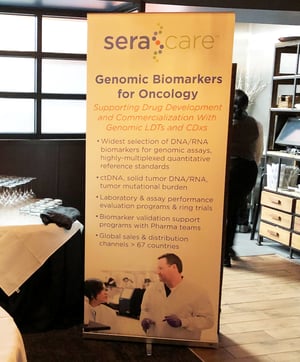One of the core aims of precision medicine is to provide a more tailored approach to disease diagnosis, therapy selection, and patient monitoring to improve the overall quality of life for patients with disease. Indeed, this aim has been at the heart of the high interest and study of the potential of liquid biopsies to improve patient care in earlier detection of cancer, treatment, and surveillance. As an active participant in this expansion, SeraCare has witnessed this rapid adoption firsthand. While we are the leading provider of tools to support clinical labs’ analytical validation of these complex assays, we also have a direct impact on the clinical utility question at the heart of many of these cell-free DNA (cfDNA) assays.
It begins with the relative perverse incentives of the healthcare system which financially rewards labs who are first movers in this space, and those who come afterwards that push the envelope of claims in order to sufficiently differentiate themselves from one another. The result is a literal arms race of performance claims surrounding cfDNA assays from larger and larger panels, to bolder claims about lowest level of sensitivity and limits of detection. All of this with the aim to drive higher testing volumes for their respective laboratories, and hopefully greater financial rewards for the institutional backers.
Yes, the goal remains the same: more tailored and personalized approach to identifying and treating patients, but in a free-for-all world where much of the validation performance data for these assays are not publicized little to no standardization across laboratories is happening.
So where does this leave clinical oncologists whose goal it is to demonstrate clinical utility of a given procedure for a class of patients?
SeraCare recently hosted a dinner seminar to discuss the very topic of how clinical labs with liquid biopsy assays can better support the development of strong evidence to first establish clinical validation of liquid biopsies and then clinical  utility in patient care. Invited speaker, Minetta Liu, MD, an oncologist at the Mayo Clinic, spoke to an audience of clinical laboratories, IVD manufacturers, pharmaceutical companies, and advocacy groups on the importance of understanding analytical performance limitations to these assays before clinicians can extrapolate clinical data sets to the question of utility. The fact is, a lot of confounding results begin to occur when testing is expanded out from a single laboratory given the lack of harmonization of these assays and a better understanding of the effective performance ranges of the tests themselves.
utility in patient care. Invited speaker, Minetta Liu, MD, an oncologist at the Mayo Clinic, spoke to an audience of clinical laboratories, IVD manufacturers, pharmaceutical companies, and advocacy groups on the importance of understanding analytical performance limitations to these assays before clinicians can extrapolate clinical data sets to the question of utility. The fact is, a lot of confounding results begin to occur when testing is expanded out from a single laboratory given the lack of harmonization of these assays and a better understanding of the effective performance ranges of the tests themselves.
If the lab is not aligned with the clinical research teams’ goals, they risk missing critical correlative data points—say with imaging analysis as a gold standard—if they do not constrain the results into those with the strongest predictive value. Labs are simultaneously hyping ever larger performance claims to differentiate themselves from their peers to gain more patient testing, but risk operating in performance ranges that mute subtle yet statistically significant correlations to gold standards and thus potentially inhibiting essential clinical utility gains that would otherwise bring higher and more consistent reimbursement.
The solution is for labs to better understand the acceptable performance ranges of their assays and to be transparent with their clients about limitations outside of these performance ranges. They can only do this by carefully and meticulously developing the analytical and clinical validation data needed to operate the assay in confidence and understanding their limits. This can be achieved through a holistic industry approach, and not through a solo effort by the lab with the fastest, most broad, or most sensitive test. The value these advanced precision medicine tests will ultimately bring to the healthcare system will only be possible through being able to reproducibly show the clinical benefit to the patient, improvement to the quality of life, and overall reduction in costs to the healthcare system.
Don’t miss out on the latest data we presented at AACR on reference standards for TMB, liquid biopsy, NTRK, fusion RNA, and more in the poster sessions. You can download our posters here.





